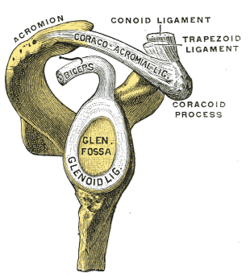Shoulder joint
The shoulder joint, articulatio humeri, is the most mobile joint in the human body.
Joint type[edit | edit source]
It is a free ball-and-socket joint.
Joint surfaces[edit | edit source]
Head - caput humeri - larger than the fossa.
Fossa - cavitas glenoidalis scapulae - widened and deepened by labrum glenoidale.
Articulating Bushing[edit | edit source]
The articular capsule begins along the circumference of the fossa and attaches to the scapula at the outer circumference of the labrum glenoidale. The attachment site on the humerus is the collum anatomicum, but on the inner side it descends lower, on the collum chirurgicum and folds into the cilia. This relatively loose sleeve allows for high joint mobility. On the ventral side, the synovial membrane protrudes from the capsule into the sulcus intertubercularis, thus creating a synovial sheath for the musculi bicipitis brachii.
Joint Reinforcement[edit | edit source]
The capsule of the shoulder joint is strengthened by the articular ligaments and tendons of the surrounding muscles.
Articular ligaments:
- ligamentum coracohumerale - in front;
- ligamentum glenohumerale – 3 ligaments located ventrally in the inner wall of the capsule;
- ligamentum coracoacromiale - (fornix humeri) - stretched horizontally above the joint.
Tendons of the passing muscles:
- in front – m. subscapularis;
- at the back – m. supraspinatus, m. infraspinatus, m. teres minor.
These four muscles that reinforce the joint capsule are clinically referred to as the rotator cuffs muscles. Inside the joint, the beginning of the long head m. biceps brachii runs from the tuberculum supraglenodiale of the scapula to the sulcus intertubercularis.
Bursae synoviales[edit | edit source]
In places of pressure and friction, between the joint capsule and the muscles, there are weight pouches, bursae synoviales: bursa subtendinea musculi subscapularis, bursa subcoracoidea, bursa subdeltoidea, bursa subacromialis and others.
Movements[edit | edit source]
Articulatio humeri is the most mobile joint in humans and movements are possible in all directions.
It is about:
- ventral flexion = sag, up to 80°;
- dorsal flexion = extension;
- abduction = abduction, possibly horizontal (then the humerus hits the coracoacromial ligament);
- adduction = shouldering;
- rotation = around the longitudinal axis connecting the caput and capitulum humeri, range of about 90°.
The combination of these movements is circumduction'. The movements of the articulatio humeri are also associated with the movements of the surrounding joints (art. acromioclavicularis, art. sternoclavicularis) and with the movement of the scapula.
Middle position[edit | edit source]
The middle position of the shoulder joint is slight abduction and flexion.
Vessels and nerves of the shoulder joint[edit | edit source]
Arteries
- They come from the periarterial vascular network into which branches from a. axillaris (a. thoracoacromialis, a. circumflexa scapulae, a. circumflexa humeri posterior and a. circumflexa humeri anterior) enter ).
Veins
- Veins leave along the supply arteries.
Nerves
- They come from n. suprascapularis, from nn. subscapulares and from n. axillaris.
Links[edit | edit source]
Related Articles[edit | edit source]
- Joints of upper limb
- Shoulder joint dislocation
- Fractures of the humeral head
- Differential diagnosis of shoulder pain/PGS (VPL)
- Joint
External links[edit | edit source]
References[edit | edit source]
- ČIHÁK, Radomír. Anatomie 1. 2., edit. and add. edition. Grada, 2001. 497 pp. ISBN 80-7169-970-5.
- GRIM, Miloš – DRUGA, Rastislav. Základy anatomie : Obecná anatomie a pohybový systém. 1. edition. Galén, 2001. 159 pp. ISBN 80-7262-111-4.


